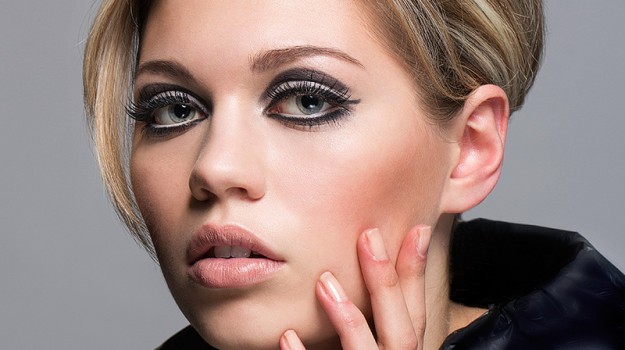How To Do 60s Eye Makeup Quick, Today
The 1960s was a youth-oriented decade – the “baby boomers” were coming of age and defined the decade as their own.
Makeup looks were at both ends of the scale, from the au naturel look of the hippie brigade to the dramatic black and white eyes of mod high-fashion, with pastel colours making their mark on the masses.
Here we look at what influenced makeup style in the 1960s, the popular colours and products, and false lashes.
The youth had a big influence on fashion. Since the 1950s, the young had disposable income to hand and it was spent on looking stylish.
London had led the way with the mod look (“modernist”) since the late fifties, and new stores catering to the fashion tastes of the younger generation popped up all over, notably in Carnaby Street and Kings Road.
The mod look peaked between early 1964 and mid-1967. During this time, youth-orientated television shows, magazines and films united young people all around the world.
The people's love for bold and amazing patterns and black and white spilled over into the white eye shadow and black crease look, as exemplified by 1960s model Twiggy on the cover of many magazines.
Hippie Culture
Later in the 1960s, the hippie counterculture made its mark with a taste for more natural faces and products, though face and body painting, synonymous with the “flower power” movement, was a riot of colour.
The feminist movement re-emerged in the sixties and was primarily focused on equality for all and the end of discrimination. Some feminists viewed makeup as objectifying women as sex objects and so wore very little; others embraced makeup and wore it as a badge of honour (as had their lipstick-wearing suffrage sisters decades before).
Music, Television and Going to the Dance
Music went hand in hand with youth-lead fashion and everything from rock and roll, Motown, pop, mod and psychedelic rock influenced the style and amount of makeup worn by the masses.
Music in the 1960s took on the messages of the youth and the era – it gave the young permission to rebel, express and assert themselves. Dances were incredibly popular, so being fashionable and dressing up to the nines was all part of the scene.
Television had new music shows like Ready Steady Go! (first aired in 1963) and Top Of The Pops (first aired in 1964), where the viewer could see their favourite artists and follow their styles. People wanted to dress like their favourite bands.
Movie Stars
 Movies both influenced and embraced the trends of the day. Elizabeth Taylor‘s makeup in Cleopatra (1963) is a good example of how “current” was mixed with “historic”, creating a trend-setting 1960s Cleopatra! The Cleopatra phase started before the film’s actual release, with companies like Revlon leading the way with Cleopatra-inspired makeup colours and design.
Movies both influenced and embraced the trends of the day. Elizabeth Taylor‘s makeup in Cleopatra (1963) is a good example of how “current” was mixed with “historic”, creating a trend-setting 1960s Cleopatra! The Cleopatra phase started before the film’s actual release, with companies like Revlon leading the way with Cleopatra-inspired makeup colours and design.Magazines often featured the glamorous looks of stars like Sophia Loren and Audrey Hepburn to indie girls Brigitte Bardot and Edie Sedgwick.
The early 1960s saw the continuation of the makeup look of the 1950s - a superior eye line, matte eye shadows (mainly in grays, greens and blues), soft blush and lipstick going From sweet reds to corals and pinks.
Just a few years later, the pale distinctive lid with a dark eye shadow fold came in. It was matched with pale lips. Pastel colors were, and this look became all the rage for young women. Older women would be more likely to stay with the more familiar (and growing) aspect of the early 1960s.
The high fashion couture of the 1960s became all about the eyes - the rest of the face was kept softer and natural, or pale and discreet.
False eyelashes were incredibly popular - the accessory of the decade.
False eyelashes were the fashion accessory of the 1960s (from around 1964) and trendy girls wore them every day. Some even wore two sets.
Lashes (both upper and lower) came on a long strip as you cut to length, or as ready-to-wear sets.
The band that the lower lashes came in could be annoying, so the girls cut them into smaller pieces.
The eyelashes were made from human hair, synthetic fibers and animal hair such as sand, mink and seal.
Eyelashes came mainly in black and brown, but could be decorated with rhinestones and glitter.
Mascara could now be purchased in a tube with a chopstick applicator, having been invented in the 1950s, but solid block products were still used too.
Block mascaras have been activated with water or, more realistic, spit, and mixed with the small brush that came with it. Max Factor block mascara could be built.
There was also cream mascara in a tube that came with a small baguette brush. Some products were waterproof, others were not.
Lash curlers were available, but recalled as "torture instruments which, if not placed quite right, really pinched your lid of the eyes."















Lovely Guide.. Thankyou
ReplyDeleteNice Post
ReplyDeleteSnipby: Best Mens and Womens salon for Haircuts, makeup, massage and beauty services